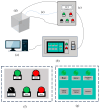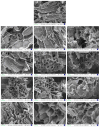Moderate Ohmic Field Modification of Okara and Its Effects on Physicochemical Properties, Structural Organization, and Functional Characteristics
- PMID: 40428612
- PMCID: PMC12110906
- DOI: 10.3390/foods14101833
Moderate Ohmic Field Modification of Okara and Its Effects on Physicochemical Properties, Structural Organization, and Functional Characteristics
Abstract
This study employed ohmic heating to investigate its impact on the physicochemical properties, structural organization, and functional characteristics of okara. Ohmic heating was applied with different field strengths and holding times. After moderate ohmic treatment, the water-holding capacity, oil-holding capacity, and swelling capacity of okara increased by 51.11%, 88.89%, and 43.64%, respectively. The microstructure and secondary structure were improved. The total sugar and soluble dietary fiber content were enhanced. The levels of active substances such as total flavonoids and total phenols significantly increased, leading to improved antioxidant capacity. The properties of okara were influenced by the field strength and holding time. This study provides new insights for the processing and development of okara, particularly in the application of functional foods.
Keywords: functional foods; modification; ohmic heating; okara.
Conflict of interest statement
The authors declare that they have no known competing financial interests or personal relationships that could have appeared to influence the work reported in this paper.
Figures










Similar articles
-
Structural, physicochemical, and functional properties of insoluble dietary fiber derived from okara by Viscozyme® L.J Food Sci. 2023 May;88(5):1994-2008. doi: 10.1111/1750-3841.16565. Epub 2023 Apr 10. J Food Sci. 2023. PMID: 37038307
-
Ultracentrifugal milling and steam heating pretreatment improves structural characteristics, functional properties, and in vitro binding capacity of cellulase modified soy okara residues.Food Chem. 2022 Aug 1;384:132526. doi: 10.1016/j.foodchem.2022.132526. Epub 2022 Feb 22. Food Chem. 2022. PMID: 35217458
-
Effects of ultrasound-assisted enzyme hydrolysis on the microstructure and physicochemical properties of okara fibers.Ultrason Sonochem. 2020 Dec;69:105247. doi: 10.1016/j.ultsonch.2020.105247. Epub 2020 Jul 1. Ultrason Sonochem. 2020. PMID: 32634727
-
Engineering processes in meat products and how they influence their biophysical properties.Meat Sci. 2013 Dec;95(4):871-8. doi: 10.1016/j.meatsci.2013.04.053. Epub 2013 Apr 29. Meat Sci. 2013. PMID: 23702340 Review.
-
Ohmic Heating: Concept and Applications-A Review.Crit Rev Food Sci Nutr. 2016 Oct 25;56(14):2338-51. doi: 10.1080/10408398.2013.835303. Crit Rev Food Sci Nutr. 2016. PMID: 25830778 Review.
References
-
- Lu F., Liu Y., Li B. Okara dietary fiber and hypoglycemic effect of okara foods. Bioact. Carbohydr. Diet. Fibre. 2013;2:126–132. doi: 10.1016/j.bcdf.2013.10.002. - DOI
-
- Privatti R.T., Rodrigues C.E.D.C. An overview of the composition, applications, and recovery techniques of the components of Okara aimed at the biovalorization of this soybean processing residue. Food Rev. Int. 2023;39:726–749. doi: 10.1080/87559129.2021.1926484. - DOI
-
- Fan X., Li S., Zhang A., Chang H., Zhao X., Lin Y., Feng Z. Mechanism of change of the physicochemical characteristics, gelation process, water state, and microstructure of okara tofu analogues induced by high-intensity ultrasound treatment. Food Hydrocoll. 2021;111:106241. doi: 10.1016/j.foodhyd.2020.106241. - DOI
-
- Vong W.C., Liu S.Q. Biovalorisation of okara (soybean residue) for food and nutrition. Trends Food Sci. Technol. 2016;52:139–147. doi: 10.1016/j.tifs.2016.04.011. - DOI
-
- Mateos-Aparicio I., Mateos-Peinado C., Rupérez P. High hydrostatic pressure improves the functionality of dietary fibre in okara by-product from soybean. Innov. Food Sci. Emerg. Technol. 2010;11:445–450. doi: 10.1016/j.ifset.2010.02.003. - DOI
Grants and funding
LinkOut - more resources
Full Text Sources

